Pied-billed Grebes use several different diving techniques but the one called “gradual sinking” is certainly the most entertaining to watch.
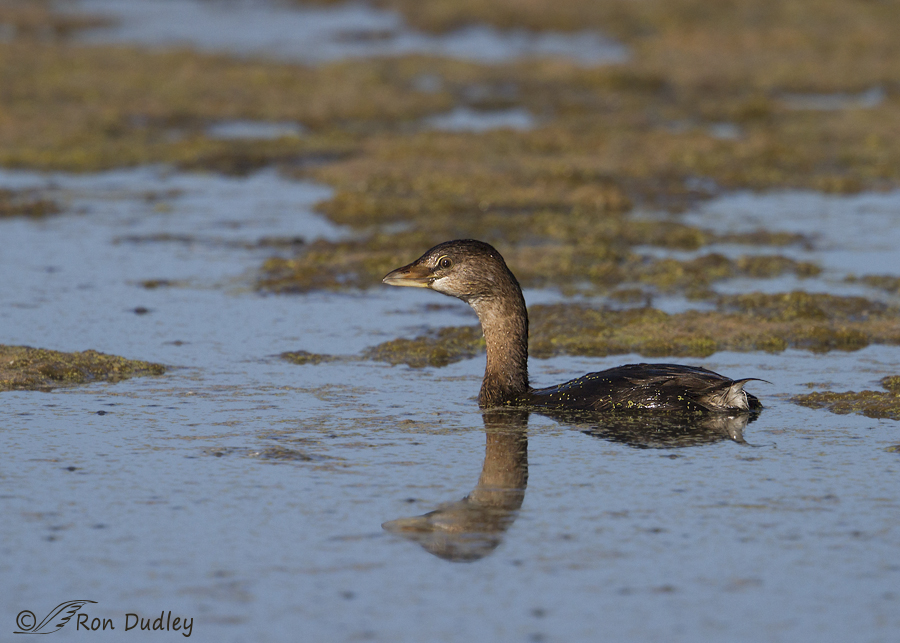
1/3200, f/6.3, ISO 500, Canon 7D, Canon EF500mm f/4L IS II USM +1.4 tc, not baited, set up or called in
This grebe kept a wary eye on me as I pulled up to its pond in my pickup five days ago at Farmington Bay. Normally I’d have passed this bird by because the setting isn’t an attractive one but I’ve only rarely been able to photograph the gradual sinking technique of the species and because the floating pond weed provided an obstacle to the bird simply swimming further away from me on the surface I wondered if it might perform for me this time. It did.
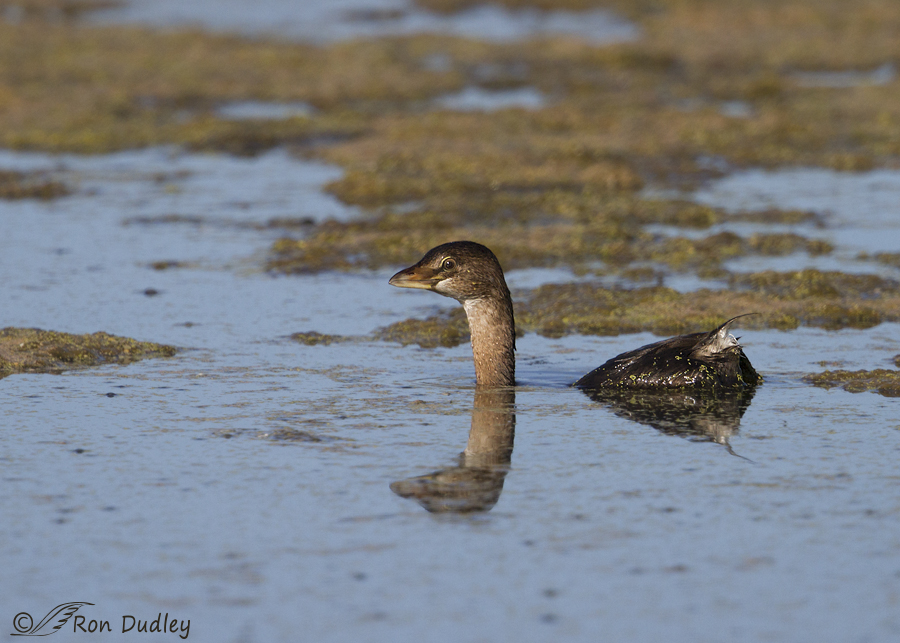
1/3200, f/6.3, ISO 500, Canon 7D, Canon EF500mm f/4L IS II USM +1.4 tc, not baited, set up or called in
When these birds are swimming on the surface, buoyancy is provided by air trapped between feathers and body and by air contained in their internal air sacs. Just prior to diving they flatten their feathers against the body which releases air trapped in their plumage and they also expel air from their air sacs. At that point their increased specific gravity allows them to more easily use any of their several diving techniques without having to tap energy reserves to dive and then remain submerged. In this instance the grebe chose to employ “gradual sinking” as its diving technique.
You can see that the grebe is static in the water and not moving forward as it begins to sink.
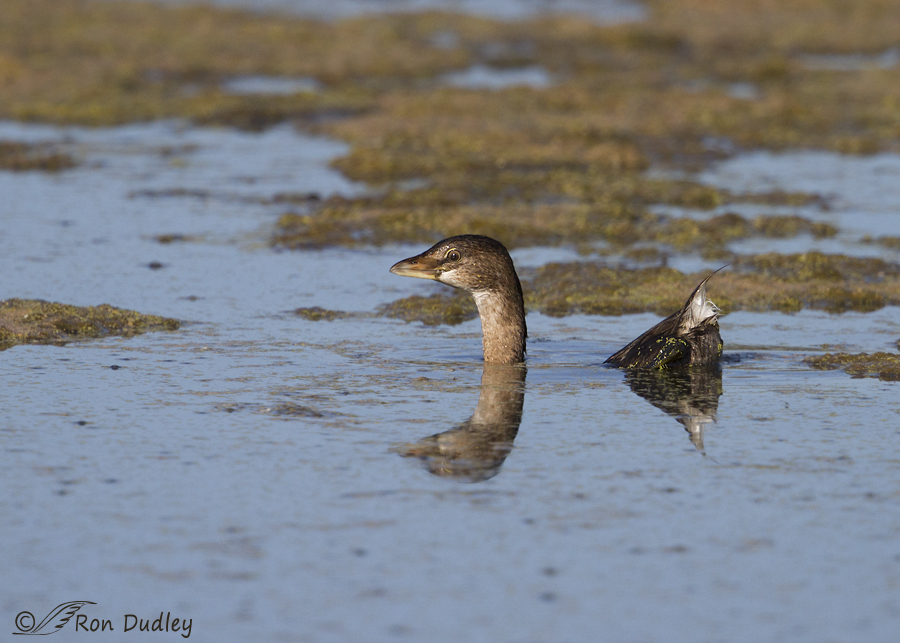
1/3200, f/6.3, ISO 500, Canon 7D, Canon EF500mm f/4L IS II USM +1.4 tc, not baited, set up or called in
In my experience they always bend their body where the neck meets the trunk which allows the weight of the head, neck and rear of the body to more efficiently “push” the bird down into the water.
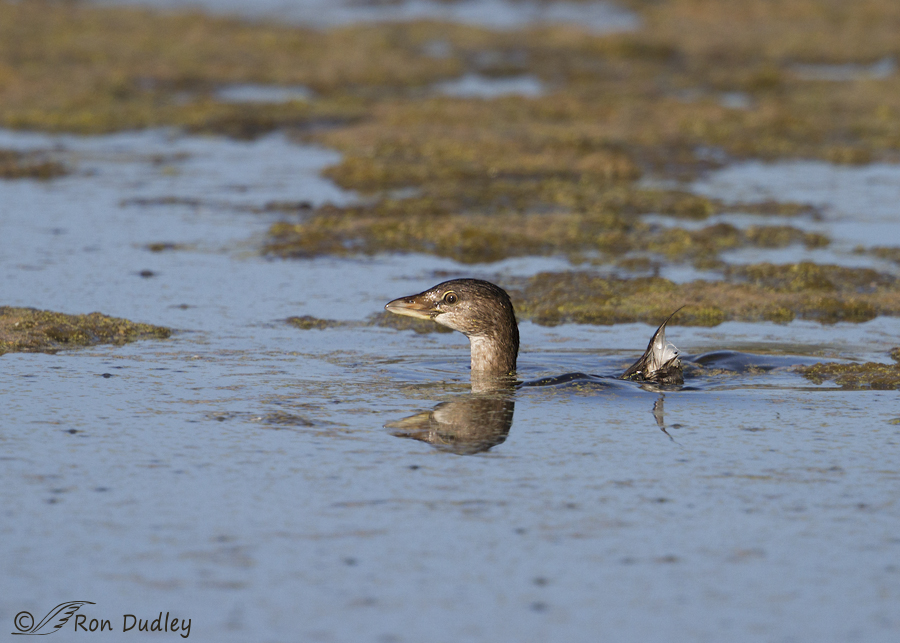
1/3200, f/6.3, ISO 500, Canon 7D, Canon EF500mm f/4L IS II USM +1.4 tc, not baited, set up or called in
Even though there is no forward motion, the disappearing head always reminds me of the periscope of a diving submarine.
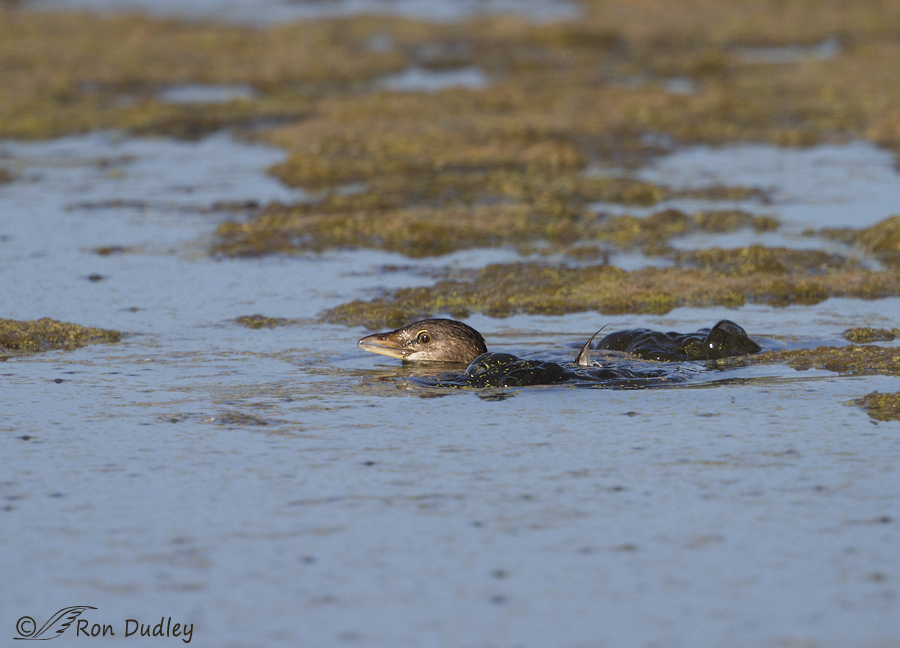
1/3200, f/6.3, ISO 500, Canon 7D, Canon EF500mm f/4L IS II USM +1.4 tc, not baited, set up or called in
The bill and tail disappear last.
They sometimes give themselves an assist at sinking with their feet. Their legs and feet are placed far back on their body and their unique anatomy allows them incredible flexibility (they can move their feet above, below or level with their body and can rotate them 90 degrees). Here you see the “water boils” as the bird uses its feet to push up against the water and force its body down.
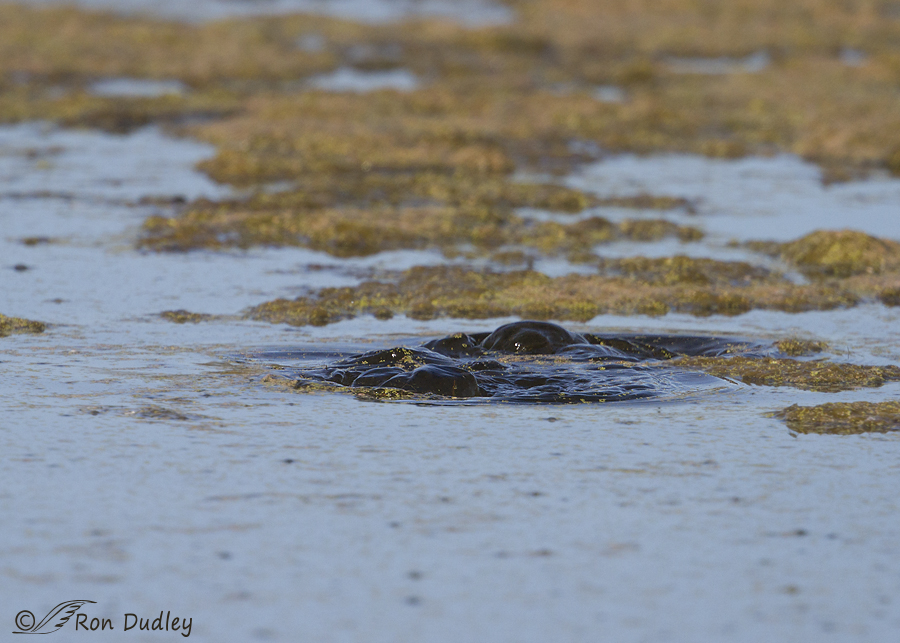
1/3200, f/6.3, ISO 500, Canon 7D, Canon EF500mm f/4L IS II USM +1.4 tc, not baited, set up or called in
And then the grebe disappeared beneath the surface. I never saw it again.
These birds can sink to any desired depth with varying amounts of body, neck and head above the surface and hold that position for some time. Several times I’ve seen them hold a partially submerged position and simply watch me, apparently in an effort to judge whether or not I’m a threat.
Ron


I’ll add my thanks to the others above for pointing out this interesting behavior. Although Pied-bill grebes are often seen in my area, I’ve never seen this. I’ll be watching for it, too.
I am so glad this bird decided to demonstrate the sinking technique for you. These pictures are fabulous. They left me smiling. A great end to my day.
How cute is that?
I’d say “pretty cute”, Dianne.
Great series from a very entertaining subject! I typically encounter them in the spring and fall around here as they are migrating through. My wife and I always enjoy watching them. I’ll have to pay more attention to them now to try and catch one sinking!
We have them year around, Jeff but they sure seem more approachable in the late fall and winter.
I had no clue they did this! If I’d seen it myself without your “education”, I would’t have believed my eyes!!! WOW!!!
Thanks, Patty. I “wow” every time I see this.
This would make a great animated GIF!
Hmmmm…., never thought of that possibility, Tim.
There’s a little waterfowl that I’ve seen do this not it’s not slow. They are colloquially called Pulldu’s because they pull to and go. I have terrible picture of one on a recent blog post.
Interesting, Arwen. I’ve never heard of a Pulldu…
I’m fairly sure that is not the right name. I think that’s just what we called it because we didn’t know the name. http://tarotbyarwen.com/blog/?p=18166 is where the pic is. And it is NOT good. Feel free to remove this link/comment if this sharing violates any rules!
Feel free to remove this link/comment if this sharing violates any rules!
Great post. I am not saying I have never seen this, but I certainly have never recognized it! Thanks Ron.
It’s easy to miss, Ken.
What a fun sequence! Love learning new things. Thanks Ron.
Thank you, Ellen.
Teaching isn’t only a profession–it’s more a worldview and a calling . I’m glad that you choose to do it , and have so much fun conveying your delight and observations ! I’m SO enjoying your blog.
Thanks, Kris
I especially appreciate your comment about teaching, Kris. Thanks for that!
Ron this is SO fun … great, great capture … fascinating!!!!
Glad you enjoyed it, Lois. Thank you.
Interesting behavioral shots Ron! Thanks for sharing the interesting info as well.
Charlotte
Thanks, Charlotte.
Entirely new to me, too, and all the more entertaining with the Pied-Billed Grebe’s steady eye contact and apparent ‘smile’! Thanks for the lesson and for the smile it gave me.
Watching this usually makes me smile too, Alison. Thanks.
Great sequence of images. I never saw that behaviour before. How long did it take from the first to the last shot?
Thank you for the explanation. Very interesting.
Jorge, I’d estimate that this sequence lasted about 2 seconds (or slightly less) but I’ve seen it happen both quicker and slower. Sometimes they stop sinking about half way through and just sit there partially submerged and watching you (or another bird if they’re reacting to it).
I should have guessed. Your parameters didn’t change a bit…
Thanks anyway.
I was going to ask the same. As often as I’ve seen Pied-billed Grebes, I’ve never witnessed this. Or perhaps, given the 2-second interval, it happened so quickly I didn’t notice with the naked eye. I will be on the look out for this through my lens now when I stroll through the local arboretum where they like to fish.
Hi Ingrid, Coincidentally I witnessed and photographed this behavior again this morning. I think it’s fairly common but not particularly conspicuous so it’s easy to miss. I wish you luck in seeing it yourself.
Excellent series Ron, and to top it off I learned something new!! Many Thanks!
Thanks, Dick. Learning new “stuff” is (nearly) always a good thing, huh?